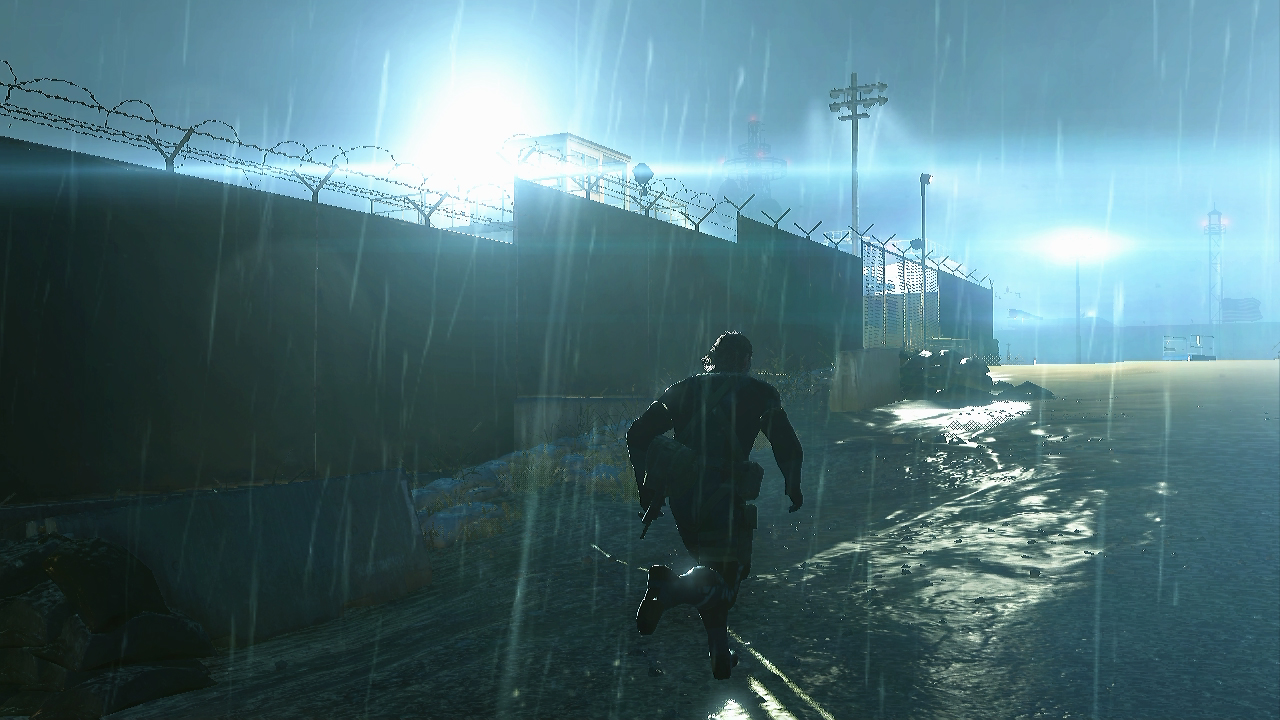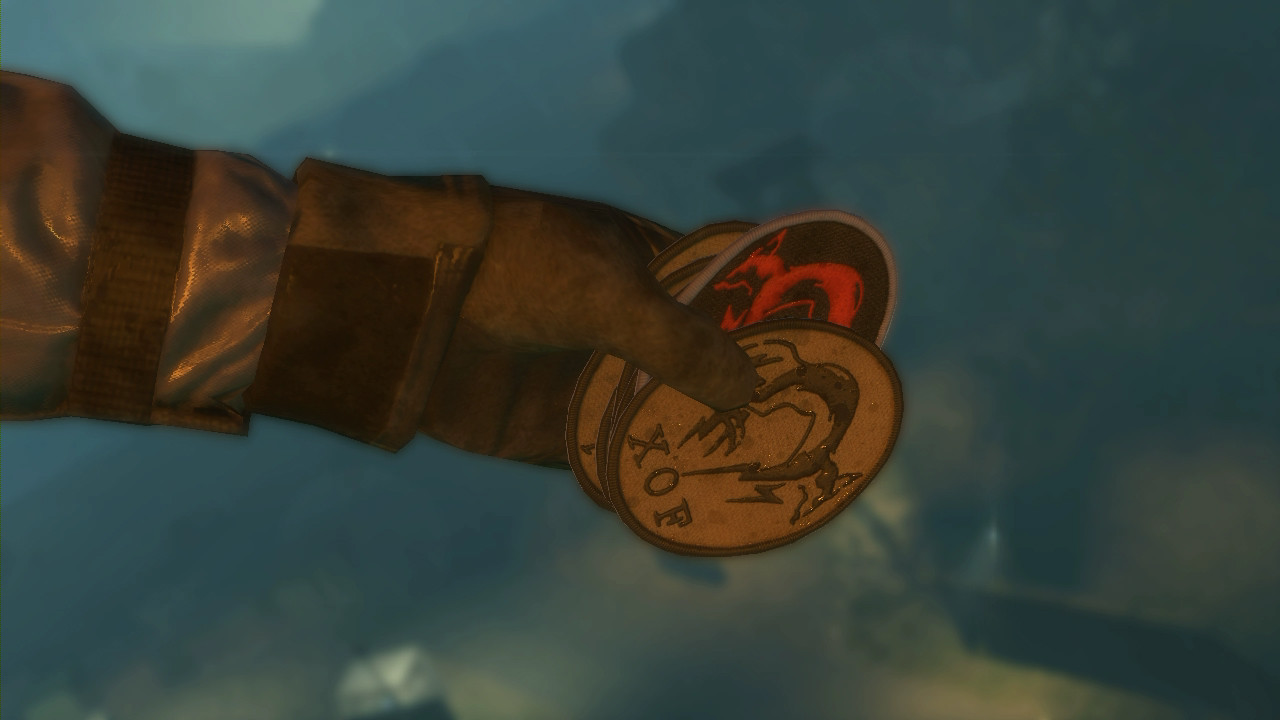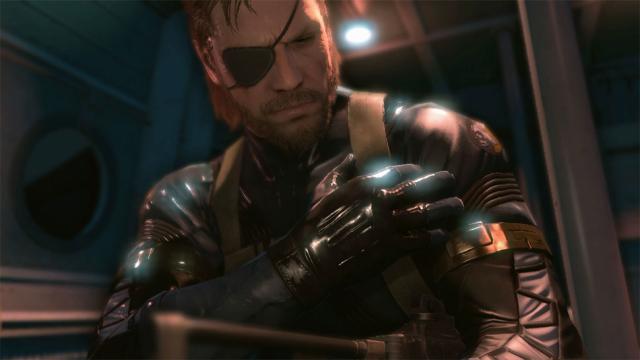Kojima Productions held an open house of its new, Los Angeles-based studio yesterday evening, and kicked things off with the first live demonstration of its upcoming flagship title, Metal Gear Solid V.
The good news: whatever your reservations about the franchise’s switch to open world gameplay, it appears to work quite well in conjunction with Metal Gear‘s stealth mechanics. The bad news (or other good news, depending on how much of a fan you are): all the baggage of the franchise’s overwritten mythology parleyed through heavy exposition and infodumps is still all here, and no amount of Kiefer Sutherland is going to change it.
About that: understandably, fans were upset when it was first announced that the Metal Gear Solid franchise would be parting ways with its most iconic of voice talents, David Hayter, for a “fresh start” with 24’s very own Jack Bauer. Fortunately, Sutherland’s voice suits Big Boss — or “Punished Snake,” going off the E3 trailer — just fine, although those used to Hayter’s smoke-scoured grumbling tones will be in for disappointment. Sutherland’s Big Boss is lighter, smoother, and less of a caricature overall — but his mere presence is going to rankle some fans, and there’s really nothing to be done about that.
So let’s get to the demo. The scene opens in the waterlogged compound first shown at GDC, where Skull Face informs a captive Chico (last seen in Metal Gear Solid: Peacewalker) that his friend (revealed to be Paz) has submitted under torture and “told them everything.” Skull Face then drops an unknown cassette into Chico’s cage. Chico pulls out a headphone jack that had been inserted into a wound in his chest (ew!) and plugs it into a tape player, which starts to play a version of Metal Gear Solid 4′s ending theme, “Here’s to You”.
As the song plays, Skull Face leaves by helicopter. We hear Big Boss and (probably) Kazuhira Miller in voice-over, establishing Paz’s and Chico’s capture and the need for Big Boss to go in (of course, completely on his own) and rescue them. This is where the player takes over.
Gone are the life meters and overhead radar of Metal Gears past.
As the player, controlling Big Boss, climbs up a rainslick hill overlooking the compound, the first thing you notice is that most conventional HUD elements have been done away with completely. Gone are the life meters and overhead radar of Metal Gears past. Instead, sighting enemies through your scope allows you to “tag” them from your current position, while you can refer to a map in the menu to set a destination marker. Nothing too revolutionary, but much more in keeping with contemporary action gameplay.

After tagging a perimeter patrol and dispensing with the mook controlling that pesky search light, it’s time to isolate one of the guards and interrogate them. Here’s where you notice the context-sensitive controls coming into play: a simple button press has Big Boss picking open the locked gate, and after he nabs a guard from behind and holds what appears to be a tranquilliser to his throat, a prompt appears to demand information. This done and the guard tidily knocked out, we check our map again and voila — a marker has appeared indicating the location of our target.
From there, it’s time for a bit of sneaking. Kojima explains that this level — Ground Zeroes in fact serves as the prologue chapter or tutorial level of Phantom Pain — is designed to introduce the concepts of the open world navigation in miniature. Big Boss crawls around amidst dynamic shadows cast by search lights, scaling rooftops and dispatching guards from behind. A circular indicator similar to that of Metal Gear Solid 4 (except flush against the screen, rather than surrounding the player character) highlights the direction of nearby enemies, helping keep Big Boss in the clear of any unwanted confrontation. Until, ah, he leaps down between a building and a truck and gets spotted by an enemy.
Kojima explains this is a sort of “helping hand” to balance out the complexities of Metal Gear Solid V’s nonlinear level design (and lack of radar).
And here’s where things get really interesting.
Instead of the usual alert noise — don’t worry! it’s coming — movement slows to a crawl. Sound drains away and all you can hear is Big Boss’s heartbeat, as his body contorts and catches sight of his discoverer. In this dilated fraction of a second, the player has a lifeline thrown to them: if they react quickly enough, they can silently eliminate their opponent, cancelling the alarm before it goes off. After that, everything picks up speed again.
Neat, huh?
Kojima explains this is a sort of “helping hand” to balance out the complexities of Metal Gear Solid V‘s nonlinear level design (and lack of radar). With so many extra places for enemies to be hiding this time, it allows for a sort of second chance to deal with getting spotted, without fouling up the whole mission or needing to wait out the alert timer in a locker somewhere. Again, it’s not an earth-shattering innovation of game design, but it’s a thoughtful addition to Metal Gear‘s stealth mechanics — and it makes sense for the character too, given how absurdly talented Big Boss is.
Several more guards are dealt with in this fashion — each one now accompanied by the signature alert noise (I told you it was coming). Big Boss sweeps through the compound and reaches his objective, which for this demo is a red embroidered FOX patch in the back of a truck. Paz and Chico will have to wait, I guess. This done, the player starts to quietly escape the compound — and then gets spotted for real.

“Ah,” Kojima says, as alarms sound off across the compound and guards begin to rush toward the player. “That wasn’t supposed to happen.”
Driving sections: still the bane of action games everywhere.
I’m sorry to say, Kotaku readers, that this was not a hands-on demo. Franchise producer Yuji Korekado is at the helm this time and — as Kojima later jokes — Korekado’s experience as producer on Metal Gear Solid: Rising had not prepared him for this much stealth gameplay.
Beset by guards and rapidly losing health, Korekado pilots Big Boss to a jeep and finally makes it out of the compound — but not without first ramming into a cement barrier and getting a tyre taken out by an enemy bullet. Driving sections: still the bane of action games everywhere.
Fortunately, the driving mechanics allow for switching between first and third person, which seems to help Korekado out. Once clear of the camp, Big Boss is able to radio for helicopter extraction, and the map is called up to designate a landing point. Even as the chopper is inbound, the real-time gameplay continues: Big Boss keeps fighting off guards until he’s already onboard and flying out, at which point a custom cinematic designed by the Los Angeles studio takes over to end out the demo.
In all, the demonstration was an interesting first look at the controls and level navigation players can expect from Metal Gear Solid V. The build shown was tailored for current-gen systems at 30fps and, graphically, you could tell the FOX Engine was not being used to the fullest — but in terms of play performance, everything appeared smooth and responsive. Context-sensitive commands were used sparingly and effectively, and though the demo railroaded things a bit in terms of how to enter the compound, once the player is in it’s clear there’s plenty of freedom to actually solving a given level.
If I had to describe Metal Gear Solid V by point of comparison, I’d say it’s Metal Gear by way of Assassin’s Creed.
Another thing many players will appreciate (and a few will not) is that after the initial cutscene infodump, dialogue is scarce. There were no interminable codec conversations, although occasionally if Big Boss sights something through his scope he’ll get a bit of voiced-over intel wired through his earpiece. Kojima explained following the demo that he wanted to keep the game within the player’s control as much as possible. Even story moments, he said, would be handled mainly through the in-game engine and through the player’s perspective.
If I had to describe Metal Gear Solid V by point of comparison, I’d say it’s Metal Gear by way of Assassin’s Creed. That’s not to denigrate it, of course: where Assassin’s Creed emphasises parkour and has a lot of vertical movement, this is much more lateral and in keeping with the stealth gameplay of the core franchise. It’s less an overhaul of previous Metal Gears, like Revengeance was, and more of a subtle nudge along the franchise’s natural evolutionary path.
It’s not perfect (damn you, vehicle section), but I came away from the demonstration feeling as though I had been witness to a very tasteful update to the series — one which better aligns the game versus its contemporaries while retaining most of its original flavour.

Comments
7 responses to “I’ve Seen Metal Gear Solid V In Action”
HYPE TRAAAAAAAAAAIIIIIIIIIINNNNNNNNNNNN
should we be nervous? i loved what they did with rising but this looks like it’s a bit too different.
Why does it say this is under PC?
Or am I wrong when it says PC right up the top?
So – what is Ground Zeroes? Is it a seperate product? A tutorial level in Phantom Pain? Why wasn’t this asked?
It’s a Prologue chapter. Think of the Tanker chapter from MGS2, or the Virtuous Mission chapter from MGS3. That’s what Ground Zeroes is.
It’s been asked by other sites, and it is just the prologue.
That sounds frustrating, but hardly a flaw.
I’m worried about regenerative health and how it might diminish the sense of fragility that traditional healths system evoke. AKA The Last of Us. But it might not be a big problem if it doesn’t take much to kill Snake. They’ll have to tune it carefully. Otherwise, they’ll be no tension, and no reason really to sneak through the game.